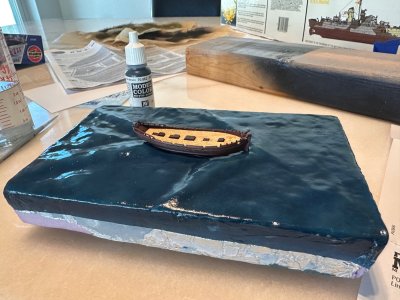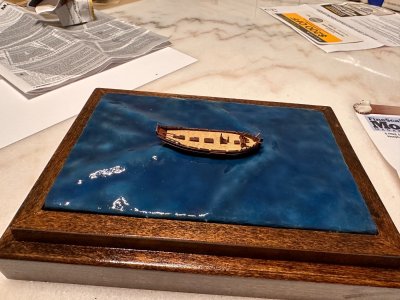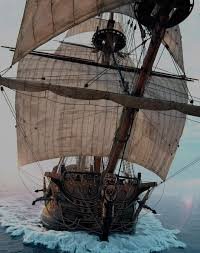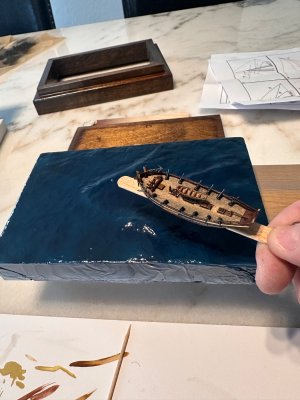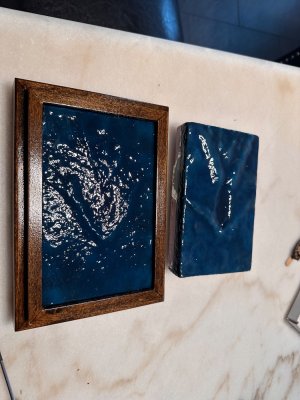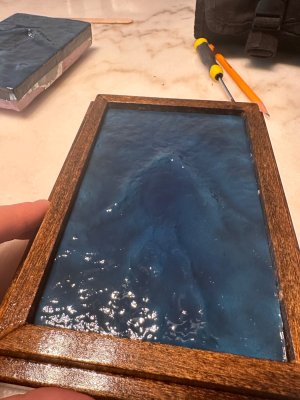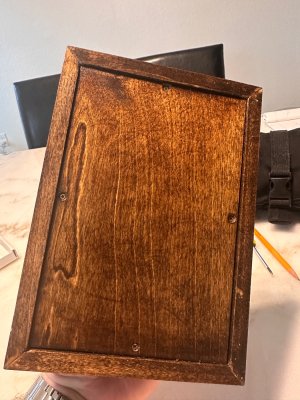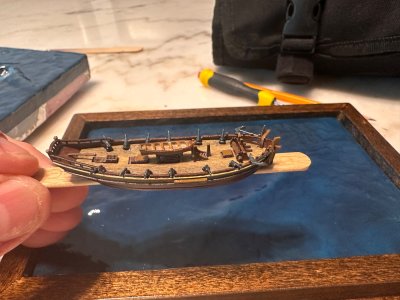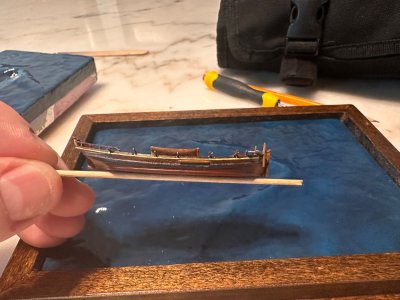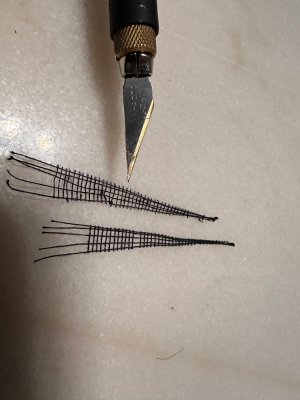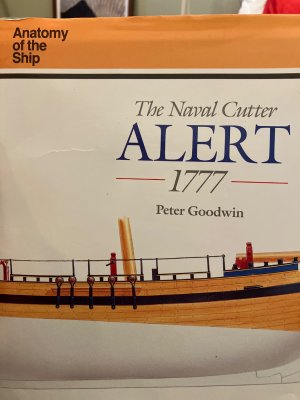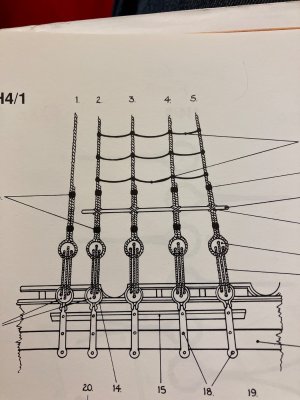-

Win a Free Custom Engraved Brass Coin!!!
As a way to introduce our brass coins to the community, we will raffle off a free coin during the month of August. Follow link ABOVE for instructions for entering.
-
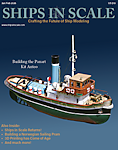
PRE-ORDER SHIPS IN SCALE TODAY!
The beloved Ships in Scale Magazine is back and charting a new course for 2026!
Discover new skills, new techniques, and new inspirations in every issue.
NOTE THAT OUR FIRST ISSUE WILL BE JAN/FEB 2026
You are using an out of date browser. It may not display this or other websites correctly.
You should upgrade or use an alternative browser.
You should upgrade or use an alternative browser.
- Joined
- Dec 3, 2022
- Messages
- 1,547
- Points
- 488

- Joined
- Oct 23, 2018
- Messages
- 874
- Points
- 403

Alert did not have 5 shrouds. The original drawing as-built and also design drawings are only showing four.
It is extremely difficult if even possible to make these off the model. It is much easier to install the shrouds, then the ratlines. The ratlines are much too thick in your picture. They were only about 1/2" in diameter. McCaffery and McNarry use wire in many instances at this tiny scale so may be a nice alternative for you. If you stay with miniature rope the following picture might help in setting up the shrouds. The picture is for a larger ship, but the principles are the same as to how it was done along with the order of dressing. The books by McNarry and McCaffery are a Godsend for anyone building at scales smaller than 1:96, especially McCaffery's book Ships in Miniature.
Allan
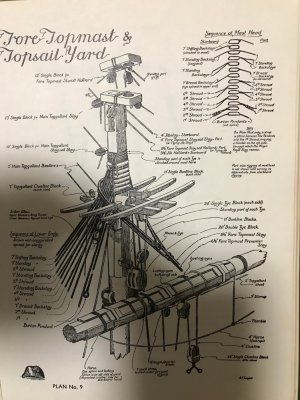
Allan

Last edited:
- Joined
- Jan 5, 2025
- Messages
- 29
- Points
- 48

It is impossible to make these off the model. It is much easier to install the shrouds, then the ratlines. The ratlines are much too thick in your picture. They were only about 1/2" in diameter. McCaffery and McNarry use wire in many instances at this tiny scale. If you stay with miniature rope the following picture might help in setting up the shrouds. The picture is for a larger ship, but the principles are the same as to how it was done along with the order of dressing.
Allan
What kind of wire? What guage?
The shrouds were about 1.77" in diameter on a vessel this size, based on the ratios for a 25 foot beamed ship in your time frame as given in James Lees' Masting and Rigging English Ships of War. I have no idea what your scale is so cannot tell you the wire gage. If, for example, your scale is 1:200, the diameter of the wire should be about 0.009" which is 34 or 35 gage. The ratlines, at 1:200 would be about 45 or 46 gage (about 0.0018"). Again, the example is for a scale of 1:200 so if your scale is different you need to calculate the gage for your particular scale. I would use uncoated copper wire as it is easily blackened with diluted liver of sulfur and is more flexible than brass or stainless steel. Do not use carbon steel, it will rust. The problem with these diameters is the smallest I can find readlily available is 0.003 which is probably OK. As you are in the US I would try McMaster Carr and other similar suppliers.
Allan.
Allan.
Last edited:
- Joined
- Jan 5, 2025
- Messages
- 29
- Points
- 48

Thanks.The shrouds were about 1.77" in diameter on a vessel this size, based on the ratios for a 25 foot beamed ship in your time frame as given in James Lees' Masting and Rigging English Ships of War. I have no idea what your scale is so cannot tell you the wire gage. If, for example, your scale is 1:200, the diameter of the wire should be about 0.009" which is 34 or 35 gage. The ratlines, at 1:200 would be about 45 or 46 gage (about 0.0018"). Again, the example is for a scale of 1:200 so if your scale is different you need to calculate the gage for your particular scale. I would use uncoated copper wire as it is easily blackened with diluted liver of sulfur and is more flexible than brass or stainless steel. Do not use carbon steel, it will rust. The problem with these diameters is the smallest I can find readlily available is 0.003 which is probably OK. As you are in the US I would try McMaster Carr and other similar suppliers.
Allan.
- Joined
- Oct 23, 2018
- Messages
- 874
- Points
- 403

That is what Goodwin shows in his book but not what the original document is showing.
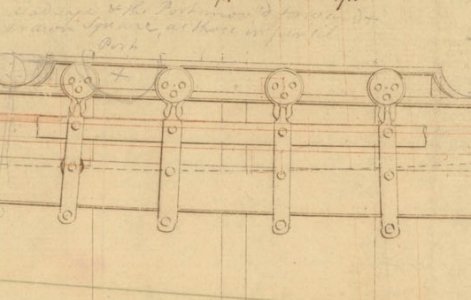
I know that someone has drawn with a pencil a "change" in the plan but it is not the common way it was done, if there was a change made. Thy normally used green ink. If you have a closer look to the original drawing you can see some other entries whites are no more readable. In my opinion these are not contemporary notes. This notes shows the position of the gunport and shrouds of the 20 years older Marshall painting.
All cutters from this time or a younger time are showing the configuration with 4 shrouds.

I know that someone has drawn with a pencil a "change" in the plan but it is not the common way it was done, if there was a change made. Thy normally used green ink. If you have a closer look to the original drawing you can see some other entries whites are no more readable. In my opinion these are not contemporary notes. This notes shows the position of the gunport and shrouds of the 20 years older Marshall painting.
All cutters from this time or a younger time are showing the configuration with 4 shrouds.
- Joined
- Dec 3, 2022
- Messages
- 1,547
- Points
- 488

Peter Goodwin (maritime author) - Wikipedia
Take your pick
- Joined
- Oct 23, 2018
- Messages
- 874
- Points
- 403

I know who Goodwin is and have a lot of his published books. But I do not agree with his interpretation of the changes. I also discussed the theme with David Antscherl.
- Joined
- Dec 3, 2022
- Messages
- 1,547
- Points
- 488

I know who Goodwin is and have a lot of his published books. But I do not agree with his interpretation of the changes. I also discussed the theme with David Antscherl.
Jolly good.
- Joined
- Sep 10, 2024
- Messages
- 934
- Points
- 353

The shrouds were about 1.77" in diameter on a vessel this size, based on the ratios for a 25 foot beamed ship in your time frame as given in James Lees' Masting and Rigging English Ships of War. I have no idea what your scale is so cannot tell you the wire gage. If, for example, your scale is 1:200, the diameter of the wire should be about 0.009" which is 34 or 35 gage. The ratlines, at 1:200 would be about 45 or 46 gage (about 0.0018"). Again, the example is for a scale of 1:200 so if your scale is different you need to calculate the gage for your particular scale. I would use uncoated copper wire as it is easily blackened with diluted liver of sulfur and is more flexible than brass or stainless steel. Do not use carbon steel, it will rust. The problem with these diameters is the smallest I can find readlily available is 0.003 which is probably OK. As you are in the US I would try McMaster Carr and other similar suppliers.
Allan.
IIRC, McCaffery also used NiChrome wire. I can't say what domestic availability is, but if you don't mind waiting for shipping from China, I've seen it available online down to .025mm (.000984 in.)
That is incredible. Thanks for posting this!! Do you have a link? The smallest I could find is 0.003" at McMaster Carr for Nichrome wire so would love to find another source with smaller sizes.McCaffery also used NiChrome wire. I can't say what domestic availability is, but if you don't mind waiting for shipping from China, I've seen it available online down to .025mm (.000984 in.)
Allan

